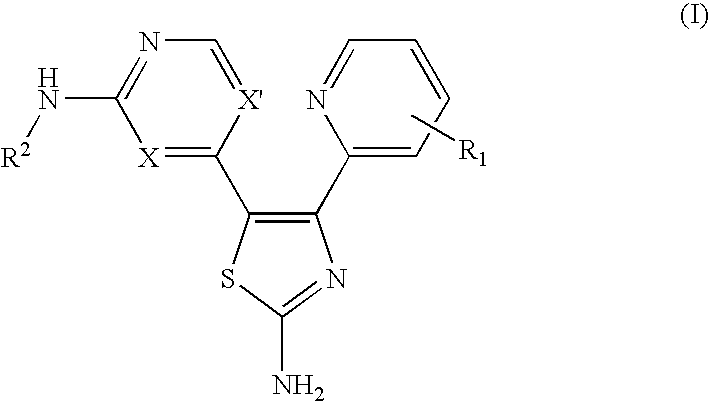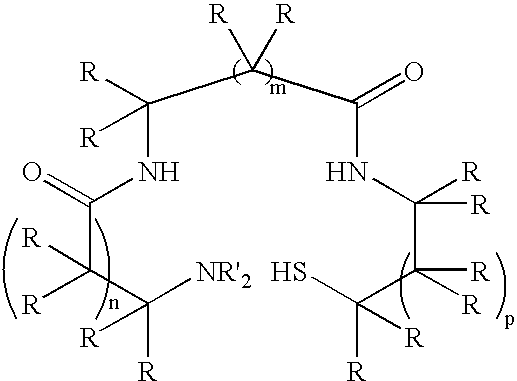Monoamine, diamide, thiol-containing metal chelating agents
a metal chelating agent and monoamine technology, applied in the field of monoamine, diamide, thiol-containing metal chelating agents, can solve the problems of inability to produce many disadvantageous radionuclides using an on-site generator, inability to achieve scintigraphic quality imaging, and inability to produce radionuclides on-site,
- Summary
- Abstract
- Description
- Claims
- Application Information
AI Technical Summary
Benefits of technology
Problems solved by technology
Method used
Image
Examples
example 1
[0241]Solid phase peptide synthesis (SPPS) was carried out on a 0.25 millimole (mmole) scale using an Applied Biosystems Model 431A Peptide Synthesizer and using 9-fluorenylmethyloxycarbonyl (Fmoc) amino-terminus protection, coupling with dicyclohexylcarbodiimide / hydroxybenzotriazole or 2-(1H-benzo-triazol-1-yl)-1,1,3,3-tetramethyluronium hexafluorophosphate / hydroxybenzotrile (HBTU / HOBT), and using p-hydroxymethylphenoxy-methylpolystyrene (HMP) or Sasrin™ resin for carboxyl-terminus acids or Rink amide resin for carboxyl-terminus amides.
[0242]Homocysteine (Hcy) was prepared by alkaline hydrolysis of L-homocysteine lactone or by reduction of homocystine using metallic sodium in liquid ammonia. Fmoc.Hcy(S-trityl) and Fmoc.Pen(S-trityl) were prepared from the appropriate precursor amino acids by tritylation with triphenylmethanol in trifluoroacetic acid, followed by Fmoc derivitization as described by Atherton et al. (1989, Solid Phase Peptide Synthesis, IR...
example 2
A General Method for Radiolabeling with Tc-99m
[0249]A 0.1 mg sample of a metal chelator or metal chelator / targeting moiety conjugate was dissolved in 0.1 mL of water, or 50:50 ethanol:water, or phosphate-buffered saline (PBS), or 50 mM potassium phosphate buffer (pH=5, 6 or 7.4) or 10% (w / v) hydroxypropylcyclo-dextrin (HPCD) in water. Tc-99m gluceptate was prepared by reconstituting a Glucoscan vial (E.I. DuPont de Nemours, Inc., Wilmington, Del.) with 11.0 mL of Tc-99m sodium pertechnetate containing up to 200mCi and allowed to stand for 15 minutes at room temperature. 25 μL of Tc-99m gluceptate was then added to the metal chelator or metal chelator / targeting moiety conjugate and the reaction allowed to proceed at room temperature for 5–30 min and then filtered through a 0.2 μm filter.
[0250]The radiochemical purity of the Tc-99m labeled reagent was determined by HPLC using the following conditions: a Waters Delta-Pak RP-18 analytical column, having dimensions of 5 μm×4.6 mm×220 mm,...
example 3
Platelet Aggregation Inhibition Assays
[0270]Platelet aggregation studies were performed essentially as described by Zucker (1989, Methods in Enzymol. 169: 117–133). Briefly, platelet aggregation was assayed with or without putative platelet aggregation inhibitory compounds using fresh human platelet-rich plasma, comprising 300,000 platelets per microlitre. Platelet aggregation was induced by the addition of a solution of adenosine diphosphate to a final concentration of 10 to 15 micromolar, and the extent of platelet aggregation monitored using a Bio / Data aggregometer (Bio / Data Corp., Horsham, Pa.). The concentrations of platelet aggregation inhibitory compounds used were varied from 0.1 to 500 μg / mL. The concentration of inhibitor that reduced the extent of platelet aggregation by 50% (defined as the IC50) was determined from plots of inhibitor concentration versus extent of platelet aggregation. An inhibition curve for peptide RGDS was determined for each batch of platelets tested...
PUM
| Property | Measurement | Unit |
|---|---|---|
| Molar density | aaaaa | aaaaa |
| Molar density | aaaaa | aaaaa |
| Molar density | aaaaa | aaaaa |
Abstract
Description
Claims
Application Information
 Login to View More
Login to View More - R&D
- Intellectual Property
- Life Sciences
- Materials
- Tech Scout
- Unparalleled Data Quality
- Higher Quality Content
- 60% Fewer Hallucinations
Browse by: Latest US Patents, China's latest patents, Technical Efficacy Thesaurus, Application Domain, Technology Topic, Popular Technical Reports.
© 2025 PatSnap. All rights reserved.Legal|Privacy policy|Modern Slavery Act Transparency Statement|Sitemap|About US| Contact US: help@patsnap.com



